Have I fermented my seeds too long
Quick question: I fermented my tomato seeds for almost two weeks. Will this negatively affect viability? I'm guessing not since they went undisturbed in a dark environment and remained under water, but I'm not sure.
Comments (37)
labradors_gw
9 years agoYou have your answer from Carolyn, the Guru.
I've had difficulties fermenting my seeds recently. I had guests staying and didn't check on them as regularly as I usually do. One variety sprouted in just a few days, one was infested with fruit fly lavae and yet another variety appeared to disintegrate after I dried them! I tossed the lot and will check on them every day in future!
Linda
Related Professionals
Fillmore Landscape Architects & Landscape Designers · Signal Hill Landscape Architects & Landscape Designers · Franklin Landscape Contractors · Raleigh Landscape Contractors · Tewksbury Landscape Contractors · Casas Adobes General Contractors · Jacksonville General Contractors · Langley Park General Contractors · Noblesville General Contractors · Parkville General Contractors · Parma General Contractors · San Marcos General Contractors · Dayton Decks, Patios & Outdoor Enclosures · Lake Morton-Berrydale Decks, Patios & Outdoor Enclosures · Riverside Decks, Patios & Outdoor Enclosurescarolyn137
9 years agoLinda, I had to laugh a bit when you mentioned fruit fly larvae, actually the larvae can be from not just fruit fly larvae, but any kind of flies that get in there, and I call them maggots. LOL
Now that grosses some folks out when they are mixed in with the wet seeds and end up on a plate drying, but that's why it's important to seperate the seeds on the plate with your fingers.
And that b'c if water stays around the maggots can still squirm, but away from water they DIE, as in RIP.
No, I never spent all that much time watching maggots die, well maybe a few times I must admit. LOL
Perhaps one of the most common errors with fermentations is to let the fermentation run too long,no liquid left, and what you get are usually brown or BLACK seeds stuck to the bottom of the container and especially the black ones won't germinate at all, or minimally.
Carolyn, the happy recipient of three boxes of outstandingly huge tomatoes sent to her, and what to do, too many for her and her cat doesn't eat tomatoes, so she's been giving them away, except for the new Italian ones which she's supposed to be checking out for everything, And another box came this week from a friend in CO with two Rocky Ford melons and some western slope peaches. When she lived in Denver and was teaching at the med school she and others East of the Rockies couldn't wait to get those melons and peaches from W CO as they were trucked in. Sigh,
labradors_gw
9 years agoHey Carolyn,
Those long thin Fruit Fly maggots (gross) were dead!!! (I knew they were FF maggots because they were hanging around and trying to get into my fermenting pots in my kitchen. At first I thought they were tomato sprouts. I didn't want to save those seeds because I didn't know if the maggots might have chewed them!
On a brighter note, you're a lucky girl to receive those lovely boxes of tommies and fruits. No doubt you'll be giving the tommies away minus their SEEDS (LOL).
Linda
reginald_317
9 years agoI fermented my tomato seeds for almost two weeks. Will this negatively affect viability? I'm guessing not since they went undisturbed in a dark environment and remained under water, but I'm not sure.
I do not know if that would adversely affect them. Carolyn gave the recommended suggestion to test-germ a few AFTER they have completely dried. Now I use no paper plates on which to dump the cleaned seeds... coffee filters are much superior, IMO. Two considerations here: seeds will not stick to them and they wick the water remaining on the dumped seeds rather quickly (I also initially place newspaper under the coffee filters). No need to separate them at all. Wait until dry and gently rub "clumps" twixt thumb and index finger and they pretty much separate of their own volition.
BTW, I "ferment" for about 4 days before "cleaning" and dumping, stirring the brew once daily.
The ferment in image is currently on day #2 of its journey to eternal glory.
Reggie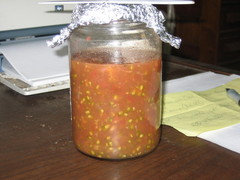
carolyn137
9 years agoReggie, for the number of seeds I was processing at a time, which could be several pint's worth of a single variety, there's no way that I could have used coffee filters.
But I do have a gripe about coffee filters and that;s about some folks who place seeds directly on wet coffee filters and then stick them in closed baggies, which is an open invitation to mold contamination.
Why do you stir the contents daily?
When the continers are set up and ready to go, the first thing to happen is an aeobic metabolism at the top of the gloop, then one hopes for a lot of mold spores to drop in, and that forms the mold layer on top and helps to convert the metobilsm to anaerobic fermentation.
And it's the products of anaerobic fermentation that are wanted, so I'm wondering about the oxygen that you introduce by stirring, and also the intactness of the mold layer that develops.
Carolyn
sheltieche
9 years agohmm, live and learn, I have not thought I wanted anaerobic fermentation
but I do as Carolyn says with my seeds,lift the mold rinse the seeds... I do place them on paper towels to dry after but I do small amounts of seeds.I suppose you can try and germinate a few and see if they will viable...reginald_317
9 years agoReggie, for the number of seeds I was processing at a time, which could be several pint's worth of a single variety, there's no way that I could have used coffee filters.
But I do have a gripe about coffee filters and that;s about some folks who place seeds directly on wet coffee filters and then stick them in closed baggies, which is an open invitation to mold contamination.Why do you stir the contents daily?
Stirring may not be indicated but has not seemed to introduce any embarrassment in my experience and breaks up globs of accreted junk. On the coffee filters, I have dried gallons of tomato brew at one time and easily used coffee filter as the media on which to dry. Now you indicate that you separate the seeds on a paper plate, one by one, after cleaning and dumping ? This, IMO, is a huge waste of effort and is totally unnecessary. After dump you DO want seeds to dry ASAP, but I would not consider giving each tomato seed its own drying domain for that purpose. Ya want a media that has wicking capacity. Paper towels do but seeds will stick to them... ditto newspapers. A hydrophobic membrane such as a plastic-coated paper plate or a ceramic or glass plate have NO wicking potential... all drying is from direct evaporation.And parenthetically, your "gripe" constitutes a logical Red Herring in responding to my original post here.
Reggielabradors_gw
9 years agoI don't buy paper plates and wouldn't want to waste a coffee filter either! I have always found that a ceramic plate/saucer works just fine for my small amount of seeds. I separate the seeds with a knife and leave the saucers on a sunny windowsill for a few days and they dry just fine. I do like the idea of wicking though!
carolyn137
9 years agoReggie, I didn't say I seperated the seeds on the plates, one by one, what I do is seperate them so there are no clumps, and then tip the plates to drain off as much water as I can.
And I want them to dry on those plates,slowly, not ASAP, b/c slow drying is best IMO.
(And parenthetically, your "gripe" constitutes a logical Red Herring in responding to my original post here.)
I must be dense today since I'm trying to see how my gripe about putting seeds on wet coffee fil
ters and putting them in baggies is a RED Herring,Have pity on me, my brain is still back on the TV tennis I've been watching from Cinci, OH,so give it to me again. (Smile)If your way of doing a fermentation works for you and the seeds come out beige and fuzzy with good germination, that's all that really matters, Right?
Carolyn
PupillaCharites
9 years agoI use diapers for my Pombinos. They are pretty sterile and wick much better than coffee filters.
I had very bad experience with coffee filters so if you use them don't use Chemex Natural bonded filters, which are great media for fungal growth and seem contaminated. I have boxes of coffee filters and I quit the addiction a few months ago so too bad, as this would be a good use.
Regular Walmart bleached white filters have a disgusting somewhat taste, something like a fishy ... maybe they have red herring in them ;-). So I don't use them because they simply disgust me for whatever causes that initial off flavor in them and I have dozens of extra boxes of diapers. Tomato seeds do not stick to diapers. It's diaper technology, diapers don't stick to baby!
Related to how much fermentation is to much is my question which belongs in this thread I think. How dry is too dry? Is there a quantitative measure of optimal seed dryness? I'm sure you don't want to dehydrate them too much as they are living.
PupillaCharites
9 years agoSeedboy,
You can do the seed tests, but it probably would be a pain unless you are looking for the difference between 50% germination and 90%.
I found this:
An experiment to determine the effect of fermentation time on tomato (Lycopersicon lycopersicum MILL) seed viability was done at the Seed Services Institute in Zimbabwe...(Rhodade cultivar) fruits were collected from a communal farmer who has been growing tomatoes for the last ten years and retaining seed in Chinamhora, Goromonzi District, Zimbabwe....
Fermented at room temperature approx. 25.0 C...
There were four fermentation times: one, two, three, and four days. During the fermentation process, the pulp was stirred after every three hours during the day in order to maintain a uniform rate of fermentation and to also avoid seed discoloration. The experiment was laid out as a complete randomized design with three replications...Seeds fermented for one day had the highest germination percentage (96.5%), while those fermented for four days had the lowest germination percentage (74.0%). There were no significant differences (p=0.05) in fermenting seeds for up to three days. However, a significant difference was observed when seed were fermented for four days...
Abnormal seedlings were those that did not show potential to develop into a normal plant even if they were to be grown under favorable conditions. They had stunted primary roots and constricted mesocotyls. Fermenting seed for four days increased the proportion of abnormal seedlings. This could have been due to hormonal imbalance and the disruption of the biochemical sequence of the germination process. Also, the effects of inbreeding depression could have been more pronounced where seeds were fermented for four days. Dead seeds were those which, at the end of the test period, were soft, but neither fresh nor had produced any part of a seedling (ISTA, 2005). These started germinating during fermentation, and died during drying. Other seeds could have been attacked by pathogens which produced enzymes that catabolyzed the embryo (Ellis et al., 1985). Lengthening the fermentation period increased the proportion of dead seed. CONCLUSION The study showed that tomato seeds can be fermented for up to three days without affecting seed viability. Seeds fermented for one day had the highest germination percentage, while those fermented for four days had the lowest germination percentage.
Of course that was done in Zimbabwe, so take note of the room temperature being 77 F.
The reference is:
Assessing the Effects of Fermentation Time on Tomato (Lycopersicon lycopersicum Mill) Seed Viability, C. Karavina, J. Chihiya ,T. A. Tigere, R. Musango, Journal of Sustainable Development in Africa Volume 10, No.4, 2009, p. 106.
Perhaps my answer is 5% moisture content is optimal? I found that here, and though it would be good to post.
carolyn137
9 years agoLinda, yes you do want anaerobic fermention. There are different anaerobic fermentations that give different end products depending on what the substrate( food) is and it's the tomato that's the food in fermentation that gives those end products.
And those acids and ezymes produced should chew up the inhibitor present in the slimy seed capsule as well
When my fermentations are complete the goopy stuff left is at the top with few seeds since the seeds should have been released from the goop
, then a cloudy liquid layer under that and then settled on the bottom the seeds.Pupilla, you don't give your name, so I'll just call you pupilla.
One to two weeks of drying seeds is enough for me, but that depends on both the humidity and the temps.
I take the seeds and put them in "liberated" scintillation bottles or into just plain envelopes and they are stored at ambient temps and humidity.
Too many seeds to store otherwise since I've never thrown out ONE seed I've saved of several thousand varieties since 1990.
If I were going to store seeds otherwise I'd dry them down to a moisture content of 6-8% before freezing them and there are indicators one can buy that determines moisture content.
The Zimbawe info is interesting but I'm not sure how relevant to lots of others, as you also noted.
Carolyn
reginald_317
9 years agoWhen my fermentations are complete the goopy stuff left is at the top with few seeds since the seeds should have been released from the goop
, then a cloudy liquid layer under that and then settled on
Pupilla, you don't give your name, so I'll just call you the bottom the seeds.
pupilla.One to two weeks of drying seeds is enough for me, but that depends on both the humidity and the temps.
I hope you did not regard diaper boy's bathroom ploy as a serious response. Surely was simply meant as a joke. As far as storage of dried tomato seeds, I do not intend to keep more than 3 years (stored in paper coin envelopes) so ambient conditions are what I subject them to. Moisture content will fluctuate with temps and humidity. If variety is deemed worthy by me, I will refresh and replace old seed stock with new from a recent grow-out and save events.
ReggiePupillaCharites
9 years ago"I hope you did not regard diaper boy's bathroom ploy as a serious response. Surely was simply meant as a joke."
You are not being nice, Reggie. I do apologize for calling the odor of Walmart coffee filters fishy and that was the only humor in my post you brought up red herring, which Carolyn interpreted precisely as I had intended. If that contributed to your assumption, I extend my apology to you with the observation that at no point was I disrespectful to you. I will watch it in the future since I see you have many ideas and want to be on your good side in case you might ever give me some advice or conversation.
Toilet humor aside, these are the materials I have to work with in my house. I'm here to learn and have learned a lot and for that I am grateful to all the posters. If for some reason this forum requires a name to be taken seriously, the thread you are replying to was started by another anonymous username with âÂÂboyâ in it. ThatâÂÂs not me, my username reflects that IâÂÂm a studious amateur and am very appreciative for the information IâÂÂve gleaned in this forum. I was formerly someone obsessive about coffee, so I couldnâÂÂt pass up a jibe to the harsh manufacturing of coffee filters which I hold strong opinions about and use for many things. Though it is not my material of choice for drying seeds, I understand why you use it and, I respect it. As a matter of fact, I believe they contain bleach which causes that odor, so bleached coffee filters may actually be useful in that they may be sterile.
Besides diapers for drying tomatoes I also have many boxes of Telfa (manufactured by Kendall) "Ouchless" Non-Adherent Pads which I plan to experiment with for seeds. Wounds do not stick to them and it is the ultimate in absorbent stickless material IMO. Model 100540/960482, laboratory sterile, is what I have and the perfect size for a couple hundred seeds. Perhaps you will understand when you are a caregiver and lose someone dear, you might be left with mountains of diapers and bandages and other items to trip over in the household.
As a technically inclined person and DIYer as many others are in the forum, I am only evaluating their properties. I am using the diapers first as I have a stock of around 1000 of them with no use. As the diapers are premium brands, they do not leave any fibrous residue on the seeds and they wick out the water extremely quickly due to the hygroscopic polymer matrix separated by a soft barrier laminate that allows for quick separation of seeds.
Essentially, you can watch your seeds dry and sandwich/rub in the soft material if there are any clumps. That is very useful for me. It has nothing to do with a toilet, which I don't find humerous. I hope you reconsider your comment and accept my extended hand in friendship. Thanks and peace ;-)
PCreginald_317
9 years agoBesides diapers for drying tomatoes I also have many boxes of Telfa (manufactured by Kendall) "Ouchless" Non-Adherent Pads which I plan to experiment with for seeds. Wounds do not stick to them and it is the ultimate in absorbent stickless material IMO. Model 100540/960482, laboratory sterile, is what I have and the perfect size for a couple hundred seeds.
OK, you seem to have expertise in the diaper dept. However, I do not find them suitable for the process of drying tomato seed... and for a number of obvious reasons. Yet, given your apparent knowledge about diaper deployment in gardening activities, perhaps you may consider trying to get Garden Web to agree to host a Diaper category in their forum. Subjects of interest there (in addition to diaper seed-saving) could be starting seedlings in soiled diapers, making diaper "tea" from soiled diapers, composting loaded diapers, saving used diapers, mulching with diapers, drying ripe fruit using diapers, etc.
Reggieseysonn
9 years agoI find saving seeds by fermentation (in tomato's own juice and meat) advantage.
When you takes seeds out of a tomato, wash them, rinse them and dry them on say paper towel, there is a good possibility that some of those seeds might not be viable. But with fermentation method the bad seeds would stay afloat when lightly stirred and then discard them... keep doing until the heaviest best seeds only sink to the bottom, readily. This way, I believe , you can have high germination rate.jmccann1966
9 years agoI am having so much trouble fermenting seeds this year :(. I take out the seeds, put them in a jar with about 3/4 cup water and sit in 1-a sunny window, 2-in a dark place and 3-in a sunny room but not in the sun. None of these places have worked. I left them for 4 days, stirring every day. Once I even tried breaking up the clumps before adding water.
I thought after this process the good seeds would fall to the bottom and bad seeds would float. (I read this on the internet, so maybe it's not true.) If this isn't true, then maybe I have been doing it right and have thrown away good seeds after all. What should I be doing after the 4 day process and is the process above the right way to do it. THANKS for any help you can give!PupillaCharites
9 years agoI don't know how what you do compares to me, but I just keep them in a warm place out of the sunlight just like making beer, and 3/4 of a cup might be too dilute, especially if it is water treated with chlorine or chloramines. I usually just add double the amout of water as tomato goop and it always works. Try using bottled spring water once to see if that helps, just in case your water is heavily chlorinated.
seysonn
9 years agoI am having so much trouble fermenting seeds this year :(. I take out the seeds, put them in a jar with about 3/4 cup water and sit in 1-a sunny window, 2-in a dark place and 3-in a sunny room but not in the sun. None of these places have worked. I left them for 4 days, stirring every day. Once I even tried breaking up the clumps before adding water.
%%%%%%%%%%%%%%%
As I understand it, you just wash and scoop the inner part of the tomato into a cup and ferment it like on the top of your refrigerator ; NO water, Add some tomato juice if it is too thick. No sunlight. When you see a layer of white goo on the top, it is done. This might take about a week, give or take couple of days. Transfer it to a tall glass.
Then add some tap water to it , stir a bit, pour about 3/4 of it out. Fill with water again,...stir a bit, pour about 3/4 of it out. Repeat until you have clear water and some good, heavy viable seeds at the bottom. Strain and dry on paper towel. ...While you are doing this, you will see lots of seeds going down the drain. Don't worry. Those seeds are good for nothing. You want the best seeds and you will end up having plenty of them.
seedboy
Original Author9 years agoCarolyn and everyone else - thank you for the responses. I've been super busy and just now checked the thread. I had already done as Carolyn suggested in her first response and the seeds are now dried. No, they had not germinated. I will try to sprout a few of each variety and see what happens. If I remember and I'm not too overwhelmed with life, I will post my results on this thread.
jmccann1966
9 years agoThanks, PupillaCharites and seysonn. Our water is chlorinated so I will try the spring water and use less. I have never tried this without water, but I'm going to try that too! Thanks for the help!
reginald_317
9 years agoI am having so much trouble fermenting seeds this year
Jimbo,
With one of your seed fermentation vessels, dump the whole mess into a larger container (perhaps twice the volume of first) and then add more water, briskly stir and wait. On the chlorination bidness, could be a problem. If concerned on that, do not buy distilled water. Merely boil tap water for about 5 minutes... the chlorine (in its antibacterial formulation) is rather volatile and is readily evaporated. Below is image of a ferment @day #2. Straight chlorinated tap water used. Still quite a few floaters, many of which I expect to sink when they lose their connections to the tomato detritus... a daily agitation can help this process.
Reggie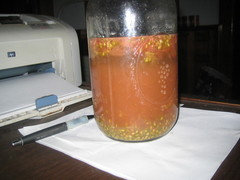
ddsack
9 years ago"I am having so much trouble fermenting seeds this year :(. I take out the seeds, put them in a jar with about 3/4 cup water and sit in 1-a sunny window, 2-in a dark place and 3-in a sunny room but not in the sun. None of these places have worked. I left them for 4 days"
The only reason to add ANY water at all, is if you have such a small batch, that the skimpy juice may evaporate before the seeds are done fermenting. To avoid adding water, put a piece of saran wrap rubber banded over the top. If you think it needs to breathe you can put a couple of pin holes in the plastic, but I don't bother. I wouldn't bother covering anything that has more than an inch of liquid, because the fungal mat will soon make a seal of it's own. Very rarely you may have juice that has too many solids and the clear liquid is not separating out and it all looks like thick tomato sauce. Just a few spoonfuls of water is all you need to add. Adding a lot water thins out the plant chemicals needed for fermentation. I don't think it makes any difference if the cup is in light or dark. Warmth does make it ferment faster.
As far as filters, I think people should use what works for them and how they like to handle their seed.
I use the flat triangular cone coffee filters, and will never go back to paper plates. I am lazy and this method lets me skip checking paper plates so I can make room for more plates as seeds dry. I like the flat filters because I can use a permanent marker to write comments about the seeds on the outside before adding them, and when dry, I can file the filters as is, alphabetically by seed name in a temporary holding shoebox where they are stored open to the air for months until I can get around to repackaging them into coin envelopes or seed ziplocks. I used to run out of table and shelf space for paper plates. With the flat cone filters, you can clothespin them to a temporary clothes line off in a corner of the house. I use a large cup to prop the filter open while I wack the rinsing sieve contents into it, then lay the filter on some newspaper and use a butter knife to spread the seeds evenly around the walls of the filter. The seeds stick to the sides of the filter as they dry, but if you are worried about them falling out, you can fold and staple or tape the top of the filter shut. If you are processing really huge batches of seeds, the filters may be too small. To remove the dry seeds, you can either scrape them off with a fingernail, or use a butter knife to scrape off the sheet of seeds, and then use your fingers to break them up. I leave the seeds in the filters until I have more time in the winter to repackage them into permanent packets, so there is no question of them being dry.
reginald_317
9 years agoReggie, for the number of seeds I was processing at a time, which could be several pint's worth of a single variety, there's no way that I could have used coffee filters.
A rather small dump of fermented to seeds... maybe 5-6 C. Note the newspaper under coffee filter. This absorbs water that is transferred from filter. Once the mess has lost most of its water, will transfer to a cardboard box (seeds remaining in filter) for further drying. I want seeds to air-dry ASAP. Do not wanna invite wild yeasts or bacs to fester in them. Have a larger seed dump scheduled on or about 08/22. This one at least 1K... Oh dear, I may be forced to employ 2 coffee filters for this dump. I am not sure I can afford this but I was given about 1000 coffee filters by a K-Kup Koffee Konvert. I do so dread the thought of being forced to buy more though.
Reggie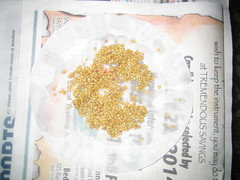
seedboy
Original Author9 years agoUPDATE: I dried the seeds, planted them in potting soil and got close to 100-percent germination. My seeds were fermented in a jar like reginald_25. Good news for anyone who uses this method and lets them go a little longer than planned.
seedboy
Original Author9 years agoUPDATE: I dried the seeds, planted them in potting soil and got close to 100-percent germination. My seeds were fermented in a jar like reginald_25 (except that I don't stir the seeds). Good news for anyone who uses this method and lets them go a little longer than planned.
jerseyjohn
9 years agoFor what it's worth, after a few years of feeling some need to ferment seeds, etc.....I decided to hell with this mess, and simply spooned seeds from ripe tomatoes, placed them down a couple hundred at a time on plain paper plates, averaging maybe 50 varieties I saved each year.
Left to dry for 30-60 days, then placed in either glass vials or plastic prescription drug sealed bags. No problem whatsoever. In future years, they have ALWAYS come up
as well as ever.Sometimes the KISS principal can be your best friend !!!!
labradors_gw
9 years agoJersey John,
You are missing the point about fermenting. It destroys pathogens on he seed coat!
Go ahead and dry them any way you like for your own use. (I have planted seeds straight from a ripe tomato because I wished to grow a plant in a container during the winter and the seeds germinated just fine).
I hope you won't share those seeds with others who do not wish to import diseases into their gardens.
Linda
reginald_317
9 years agoLeft to dry for 30-60 days, then placed in either glass vials or plastic prescription drug sealed bags. No problem whatsoever. In future years, they have ALWAYS come up
as well as ever.Sometimes the KISS principal can be your best friend
Yea John, I agree that over-engineering and unnecessarily complicating things is not very productive and is, in fact, usually a waste of resources. Now my buddy in OH has done it both ways and now does not ferment any seeds for saving. And has had no problems either.
I ferment primarily because the process "cleans" the seeds and no repeated rinsings are needed to remove unwanted detritus. If some nasties are dispatched in the process, fine.Below are about 42 gms of fermented and dried seed of one variety, saved in 3 ferments and dumps. These are now in equilibrium (constant weight... ñ 0.1% weight change on successive weighings), with ambient conditions.
Reggie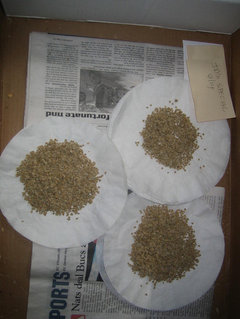
siouxzin
9 years agoI have a question, does the fermentation process change how the seed looks? I have done this (and perhaps for too long) but my seeds appear grey in color and a little "fuzzier" than ones just dried on a paper towel.
seysonn
9 years agoSiouxzn,
I think you are right. Fermentation change the color to light dull greyish appearance.
Fermentation produces a substance caled "Lactic Acid". Obviously, acid will etch and create a dull surfaces. That is how supposedly it destroys the pathogens and bad bacteria. That is how pickle is make, by lacto fermentation with salt..A trick to speed up fermentation:
Add maybe a tsp of plain yogurt whey. It is like adding yeast to grape juice to speed up the process. a piece of rotten tomato will do the same. Rotting in this case is fermentation.
About Adding Water:
If you add chlorinated tap water, probably it will kill the bacteria responsible for fermentation. It is ok to add bottled water. This is the common practice for making pickle by fermentation also.siouxzin
9 years agoah ok. good to know. I was worried that perhaps I ruined several batches. Also, I am bummed I did not hop in this particular forum sooner, I missed out on your seed swap.. :( (Although this year I do not have a ton to contribute). I look forward to next year where I can participate and send a good amount in as well!
:)
HU-219471218
3 years agoI'm new to saving tomato seeds. I think I have failed :( . I didn't get a layer of goop, or only a little, in my jars of seeds. My mistake, I think was that I washed most of the tomato pulp and jelly off in a little sieve before putting them in jars with water. Will they still germinate? I also let them soak too long, about two weeks! (although seedboy says he got germination even with that length of time). What do you think?
labradogs
3 years agoI think that you should take a couple of seeds and try to germinate them. I use damp paper towel inside a baggie and I check it every day.
For seed saving, I just squeeze the seeds and juice into a small container and leave it 4 or 5 days on a windowsill where I see it every day. It will usually form a fungusy mat by then, but not always..... I scrape the mat off the top, then pour everything into a sieve and pour running water over it to clean the seeds.....


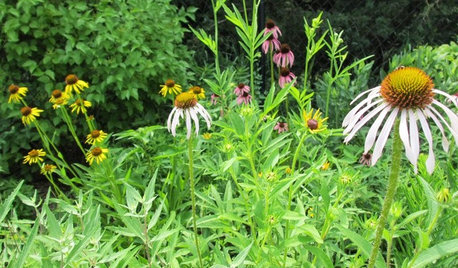











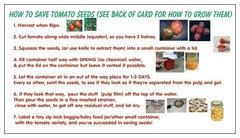



carolyn137